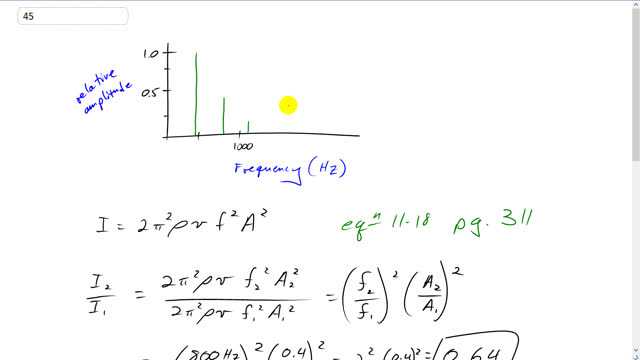
Approximately what are the intensities of the first two overtones of a violin compared to the fundamental? How many decibels softer than the fundamental are the first and second overtones? (See Fig. 12–15.)


In order to watch this solution you need to have a subscription.
This is Giancoli Answers with Mr. Dychko. This graph shows the relative amplitude of the different harmonics present when the violin is playing a single note. And the perceived pitch at that node is going to be the fundamental frequency and then these overtones give that note some color that make it distinctly a violin sound. So, the intensity is going to be 2π squared and density of air times the speed of sound and air times the frequency squared times its amplitude squared. And when we compare intensity of the second harmonic to the intensity of the first harmonic or fundamental we can divide them, and we get 2π squared ρ v f2 squared A2 squared divided by the same constants that are going to cancel anyway times if we can see 1 squared times amplitude 1 squared. So, that's f2 over f1 squared times A2 over A1 squared. It looks like frequency 2 is about 800 hertz and frequency 1 is about 400 hertz, and you might guess a little differently when you're reading the graph. And you square that ratio. And then amplitude 2 looks like it's about 0.4 here. Whereas amplitude 1, I think is defined as 1. And we square that ratio too. So, it's 2 squared times 0.4 squared which is 0.64 is the ratio of intensities of the first overtone to the fundamental, the 2nd overtone or a third harmonic divided by the first intensity it's going to be f3 over f1 squared times A3 over A1 squared. And frequency 3 through the harmonic, 2nd overtone looks like it's about 1,200 hertz. And divide that by 400 hertz squared. And then this looks like it lines up at about 0.2 or so. This is 0.25 that little division and this is slightly below that. So, let's say it's 0.2 and square that, and that gives 3 squared times 0.2 squared, which is 0.36. And expressing these ratios of intensity with the decibel scale means we go 10 times logarithm of the ratio. So, 10 times log of 0.64 is negative 2 decibels. And comparing the sound level of the third harmonic to the first is 10 log 0.36 which is about negative 4 decibels. So, at the sound level of the third harmonic is about 4 decibels lower than the first harmonic and 2 decibels lower for the second harmonic.